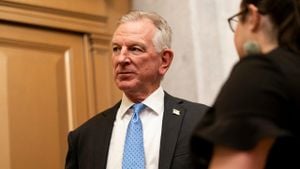The political spotlight often casts long shadows, and for Vice President Kamala Harris, the light has dimmed considerably since her presidential campaign faltered. A recent discussion by Democratic strategist James Carville summarized the sentiments surrounding her campaign failures, pinpointing how her inability to distinguish her political identity from President Biden's led to disillusionment among voters.
At the heart of Carville's critique lies Harris' awkward moment on The View, where she struggled to answer a direct question posed by Sunny Hostin: "How would you be different than Biden?" Her response, or lack thereof, said it all. According to Carville, this moment crystallized Harris's challenges, serving as the "money question" she needed to seize but failed to grasp. He remarked, "You freeze! You literally freeze and say, ‘Well, I can’t think of anything.’" This misstep, as highlighted by multiple sources, appeared to encapsulate the broader concerns many had about her campaign's direction.
Throughout the campaign, Harris faced criticism not just from her opponents but also from some within her party. The atmosphere shifted significantly when analyses began to circulate around the effectiveness of her campaign strategies. Critics pointed to her reliance on celebrity endorsements and high-profile events, which were fine—but left many blue-collar workers feeling overlooked. This sentiment was dramatized when workers at the Microsoft data center construction site were served what one called "an insulting luncheon" as part of Harris's outreach efforts. Meals described as “a single-slice-of-ham sandwich on stale bread” hardly represented the culinary or rhetorical substance many expected.
One union member, who preferred to remain anonymous, expressed his frustration with the campaign approach. “It’s not like we were expecting filet mignon,” he said, “but even sandwiches or barbecue wouldn’t have felt so insulting.” His comments reflect how widely many viewed the campaign as disconnected from the values of working-class Americans, which could explain Harris’s struggles to gain favorable ground among union workers. The man noted, “They cared more about the aesthetic of their brand than actually trying to convince us.”
The parallels between Harris’s restaurant quality and her connection—or lack thereof—with working-class voters have been starkly drawn, especially when juxtaposed against the lavish spending on celebrity endorsements and high-profile events. Harris's team reportedly spent millions coordinating events with stars like Oprah Winfrey and entertainers like Beyoncé, but many felt these efforts were superficial. The stark contrasts of campaign priorities opened the door for voter skepticism.
Carville’s assessment didn’t just end with the The View fiasco. He noted there’s persistent unease within the Democratic Party about its direction, particularly as swing-state voters indicate their desire for change—something they didn’t feel was being delivered through Harris’s campaign messaging. A significant hurdle for Harris has been her public perception: many see her as being unable to carve out her own distinct policy proposals, relying instead on the existing Biden agenda.
Adding to Harris's challenges were recent shifts within voter preferences, particularly evident among Christian voters who felt disconnected from her campaign. Surveys indicated significant support for Harris among nonbelievers; conversely, many traditional faith-based demographics were hesitant to rally behind her. This demographic shift has reinforced her need to stem the tide of disengagement from core constituencies within her party.
Returning to Harris's media engagements, media reports confirmed the repercussions of her failure on The View. Analysts noted the moment ricocheted through the Democratic Party’s internal polling, landing Harris squarely on Trump’s radar, who jumped at the chance to use the incident to stoke his campaign’s fire. Aminated by his advisers' excitement, the Trump campaign ran advertisements pointedly showcasing Harris’s blunder since they perceived it as pivotal to asserting his own branding as the “different” choice.
Carville, summing up the critique, stated, "The Democrats didn't connect with the electorate more broadly. We had people wanting change, and they didn’t know how to give it to them." When the dust settles, he predicts Harris’ response to Hostin’s question will not just be remembered as another campaign moment but as emblematic of her wider disconnect with the voting public.
Looking back, many political analysts agree Harris’s campaign needed clearer distinctions, more relatable interactions, and policies reflecting the desires of middle and working-class America, rather than high-profile celebrity spectacles. Her aides' focus seemed to be veering off-course, failing to create authentic engagements with the very voters she needed.
The bottom line for Harris’s team, as they dissect the lessons learned from the 2024 campaign, is the stark realization of the consequences from unintentional disconnects. They had to grapple with missed opportunities to forge connections, as the energy behind the campaign stuttered against voter expectations, culminating in disappointing outcomes far away from their initial ambitions.
For now, the path forward is uncertain. The Harris campaign does hold lessons for future candidates and the Democratic Party as they reconsider how they relate to and engage with the electorate. A more nuanced, grounded approach, rather than one merely framed around star power and glitzy events, may be necessary to rebuild trust with voters who yearn for authenticity and genuine representation.
What remains clear is the importance of drawing on real dialogues with voters and showcasing strong commitments to issues affecting everyday Americans. The reflections from Carville and others will undoubtedly become part of political history lessons, shining light on how campaigns can succeed or stumble based on their resonance with the people they aim to serve.



